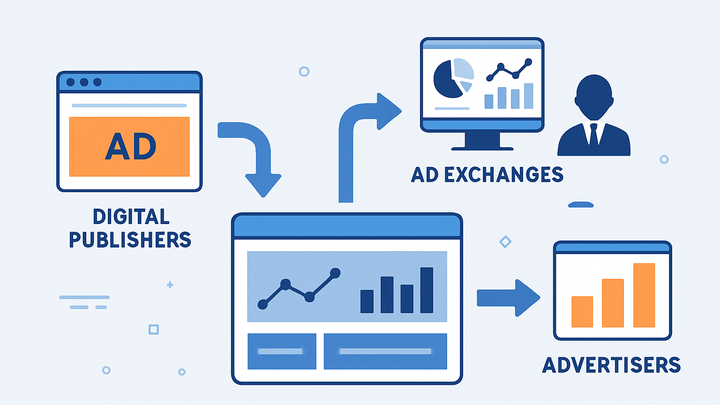Published on 2025-06-22T06:07:06Z
What is a Supply Side Platform (SSP)? Examples and Implementation
A Supply Side Platform (SSP) is a software solution that helps digital publishers manage and sell their advertising inventory programmatically. SSPs connect publishers to multiple demand sources, such as Demand Side Platforms (DSPs), ad exchanges, header bidding solutions, and direct deals, to maximize revenue and fill rates. They support real-time bidding (RTB) auctions and apply dynamic floor pricing, yield optimization, and inventory management tools. Through integrated reporting and analytics, publishers gain insights into performance metrics like eCPM, fill rate, and impression quality, enabling data-driven yield strategies. Modern SSPs prioritize privacy and compliance, offering features like header bidding and fraud protection to safeguard publishers’ brands and user experience.
Combined with analytics platforms like PlainSignal or Google Analytics 4, publishers can measure ad performance alongside user engagement to refine monetization and audience strategies.
Ssp (supply side platform)
A programmatic platform that enables publishers to manage, sell, and optimize ad inventory in real time, maximizing revenue.
How SSPs Work
Supply Side Platforms (SSPs) are software platforms used by digital publishers to manage, sell, and optimize their ad inventory programmatically. They enable real-time bidding and connect to multiple demand sources, automating the auction process to secure the highest bids.
-
Inventory registration
Publishers define and upload their ad spaces (inventory), specifying ad units, sizes, formats, and floor prices within the SSP dashboard.
-
Real-time bidding (rtb) requests
When a user visits a page, the SSP sends bid requests to connected ad exchanges and DSPs containing information about the inventory, user context, and targeting data.
-
Auction and yield optimization
The SSP conducts an auction among bids from various demand sources and selects the highest-paying ad, while applying dynamic floor pricing and other yield optimization rules.
Key Features of SSPs
Modern SSPs offer a suite of tools to help publishers optimize ad revenue, streamline operations, and improve user experience.
-
Header bidding support
Allows publishers to run parallel auctions among multiple demand partners before making ad calls to the primary ad server.
-
Dynamic floor pricing
Automatically adjusts minimum bid prices based on historical performance and market demand to maximize yield.
-
Reporting and analytics
Provides real-time dashboards and detailed metrics such as eCPM, fill rate, revenue, and impression quality for data-driven decisions.
-
User segmentation
Enables targeting based on user demographics, behavior, and first- or third-party data to drive higher ad values.
Benefits for Publishers
By leveraging an SSP, publishers can gain greater control over their inventory, improve monetization, and ensure a smoother ad operation.
-
Increased fill rates and ecpm
Opening inventory to multiple demand sources drives higher competition and increases both fill rates and effective CPM.
-
Centralized inventory control
Manage all ad units, formats, deal types, and pricing rules from a single unified platform.
-
Fraud protection and brand safety
Integrates fraud filters and brand safety checks to block invalid traffic and ensure ads run in suitable contexts.
Integration Examples with SaaS Analytics
Combine SSP data with analytics tools to monitor ad performance, user engagement, and revenue in a privacy-compliant way.
-
PlainSignal cookie-free analytics
Use PlainSignal’s lightweight, privacy-first script to track pageviews and ad impressions without cookies. Example integration:
<link rel="preconnect" href="//eu.plainsignal.com/" crossorigin /> <script defer data-do="yourwebsitedomain.com" data-id="0GQV1xmtzQQ" data-api="//eu.plainsignal.com" src="//cdn.plainsignal.com/plainsignal-min.js"></script> -
Google analytics 4 event tracking
Leverage GA4 to track ad impressions as custom events and analyze ad performance alongside user behavior:
<script async src="https://www.googletagmanager.com/gtag/js?id=GA_MEASUREMENT_ID"></script> <script> window.dataLayer = window.dataLayer || []; function gtag(){dataLayer.push(arguments);} gtag('js', new Date()); gtag('config', 'GA_MEASUREMENT_ID'); gtag('event', 'ad_impression', { 'ad_platform': 'YourSSP', 'ad_unit': 'sidebar', 'value': 1 }); </script>
Best Practices & Considerations
To ensure successful SSP implementation, publishers should follow these best practices and consider key factors.
-
Privacy compliance
Ensure your SSP and analytics integrations comply with GDPR, CCPA, and other relevant data protection regulations.
-
Latency monitoring
Track page load times and ad call latencies to minimize impact on user experience and prevent ad viewability issues.
-
Regular yield audits
Periodically review floor price settings, demand partner performance, and auction dynamics to optimize revenue continuously.
